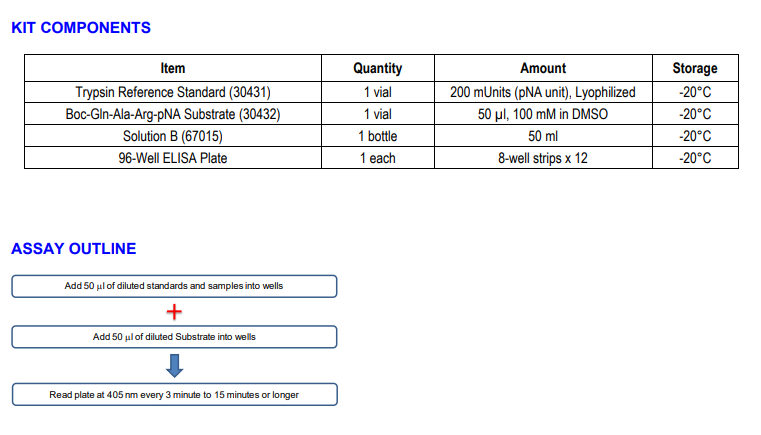Description
Trypsin Activity Assay Kit - Cat Number: 3043 From .
Research Field: Allergy, Enzymes
Clonality: N/A
Cross-Reactivity:
Host Origin: N/A
Applications: N/A
Isotype: N/A
Detection Range: 67 units/ml-9 units/ml
Sample Type: Serum, Plasma, Culture Media
Concentration: N/A
Immunogen:
PRODUCT SPECIFICATIONS
DESCRIPTION: Assay kit to measure trypsin activity
FORMAT: 96-well ELISA Plate with removeable strips
ASSAY TYPE: Chromogen Assay
ASSAY TIME: 15 to 120 minutes
STANDARD RANGE: 9 mUnits/ml to 200 mUnits/ml
NUMBER OF SAMPLES: Up to 42 (duplicate) colorless samples/plate and up to 21 (duplicate) colored samples/plate
SAMPLE TYPES: Tissue homogenate, cell homogenate, culture media, or purified enzymes
RECOMMENDED SAMPLE DILUTIONS: 1:1 (at least)
CHROMOGEN: Uses a Boc-Gln-Ala-Arg-pNA substrate (read at 405 nm)
STORAGE: -20°C
VALIDATION DATA: N/A
INTRODUCTION
Trypsin is a mammalian serine protease and a member of the PA Clan (proteases of a mixed nucleophile, superfamily A), the largest of the cysteine and serine protease families. The PA Clan, which also includes trypsin-like proteases, can hydrolyze positively charged amino acid peptide bonds in polypeptide chains, specifically the carbonyl group on Arg or Lys (1), effectively degrading peptides and proteins. As such, trypsin produced by the pancreas plays a key role in facilitating protein digestion and absorbance of foods in the small intestine. It also regulates the gastrointestinal immune response by controlling microbicide concentrations in the intestinal lumen and maintaining the integrity of the epithelial barrier (2-3). Due to these capabilities, trypsin is widely used in protein or peptide-related research for synthesizing and sequencing peptides, maintaining cultured cells, and digesting proteins (4). Recently, it was reported that proteinases in house dust mites promoted allergenicity to proteins, resulting in allergic reactions (5). This suggests that proteinases may play roles in the development of Type I allergies. In order to validate the study results, the ability to measure enzyme activity is critical. , Inc. introduces a chromogenic Trypsin Activity Assay Kit (Cat # 3043) which uses a Boc-Gln-Ala-Arg-pNA substrate to measure trypsin-like enzyme activity in 15 minutes or more (up to 120 minutes, depending on the enzyme activity in samples). The trypsin cleaves the carbonyl group in the Arg of the substrate, liberating p-nitroanilid (pNA) which produces a yellow color and can be quantified using optical density (6). This kit works for trypsin and any proteinase/peptidase which cleaves the substrate. Therefore, to accurately analyze a specific proteinase’s activity, it may be necessary to add proteinase inhibitors to inactivate other proteinases in samples. This kit, which employs a short assay time and a microplate format, is ideal for assaying many samples, as compared to traditional cuvette readings or gel assays (7). For more applications, please refer to published research references.

NOTES BEFORE USING ASSAY
NOTE 1: It is recommended that the standard and samples be run in duplicate.
NOTE 2: Warm up all buffers to room temperature before use.
NOTE 3: Measure exact volume of buffers using a serological pipet, as extra buffer is provided.
NOTE 4: For partial reagent use, please see the assay protocol’s corresponding step for the appropriate dilution ratio. For example, if the protocol dilutes 50 µl of a stock solution in 10 ml of buffer for 12 strips, then for 6 strips, dilute 25 µl of the stock solution in 5 ml of buffer. Partially used stock reagents may be kept in their original vials and stored at -20⁰C for use in a future assay.
NOTE 5: This kit contains animal components from non-infectious animals and should be treated as potential biohazards in use and for
disposal.

ASSAY PROCEDURE
1. Prepare Trypsin References: Four levels of reference standards are recommended. Dissolve 1 vial of Trypsin Reference Standard in 1 ml of Solution B (200 mUnits/ml) and keep it as a reference stock and 100% control. Add 100 µl of this standard stock solution to 150 µl of Solution B to make a 67 mUnits/ml solution (Reference 1). Then serially dilute it with Solution B. For example, mix 125 µl of the 67 mUnits/ml solution with an equal volume of Solution B to make a 33 mUnits/ml solution (Reference 2), and then repeat it two more times for 18 and 9 mUnits/ml solutions (Reference 3 and 4, respectively). The remaining 200 mUnits/ml reference stock may be stored at -20°C for use in a second assay. , Inc. recommends making fresh serial dilutions for each assay.

Prepare Samples: Samples can be tissue homogenates, cell homogenates, culture media, or purified enzymes. Centrifuge at 10,000 rpm for 5 minutes, then use the supernatant if the samples include insoluble materials. Dilute samples at least 1:1 with Solution B depending on the estimated trypsin levels in the samples. Two to three different sample dilutions are recommended if the trypsin levels
in the samples are unknown.
NOTE 1: Samples must be diluted with Solution B to maintain optimal assay conditions.
NOTE 2: If the sample solution has color such as culture media, , Inc. recommends using sample blank wells for the assays.
Please refer to Step 4.
NOTE 3: Depending on the needs of the experiment, please consider appropriate protease inhibitors, especially trypsin inhibitors because they will affect the assay’s outcome.
NOTE 4: Freshly prepared samples are recommended for this assay. Samples can be immediately stored at -20°C after preparation and still be used for the assay. However, the enzyme activities will depend on the types of samples.
3. Prepare Substrate Dilutions: Prepare the substrate solution with Solution B as shown in the following table (16 wells = 2 strips).

Add 100% Control, References, and Samples: Choose 4-1 or 4-2 depending on samples 4-1. Colorless Samples: Use the plate layout for colorless samples. Add 50 µl of the following into their respective wells: 200 mUnits/ml trypsin reference standard stock into the 100% control (C) wells, Solution B into the (B) wells, 67 - 9 mUnits/ml References into the (R1- R4) wells, and samples into the orange wells in duplicate. For example, add 50 µl of Sample 1 into the S1 wells, 50 µl of Sample 2 into the S2 wells, etc. Proceed to Step 5-1. 4-2. Colored Samples: Use the plate layout for colored samples. Add 50 µl of the following into their respective wells: 200 mUnits/ml trypsin reference standard stock into the 100% control (C) wells, Solution B into the (B) wells, 67 - 9 mUnits/ml References into the (R1- R4) wells, and samples into the orange and gray wells in duplicate. For example, add 50 µl of Sample 1 into the S1 and SB1 wells, 50 µl of Sample 2 into the S2 and SB2 wells, etc. Proceed to Step 5-2.
5. Add Substrate:
5-1. Colorless samples: Add 50 µl of substrate solution to all wells at room temperature (25°C).
5-2. Colored samples: Add 50 µl of substrate solution into the purple and orange wells and add 50 µl of Solution B into the gray wells at room temperature (25°C).
6. Read: If it is possible, keep the plate reader temperature at 25°C. Read the plate at 405 nm every 3 minutes for 15 minutes. If the trypsin activity is low, keep reading the plate every 10 minutes, up to 120 minutes.
NOTE: If OD values of samples are the same as the OD values of the 100% control, dilute samples for another assay or adjust using kinetics analysis.
CALCULATING RESULTS
1. Average the duplicated OD values for the standards, blanks (B),100% control (C), references (R1-R4), and samples (S).
NOTE: If using sample blanks, the averaged OD values of the sample blanks (SB) are subtracted from the averaged OD values of the
samples (S).
2. One unit of trypsin activity (1 pNA unit) is defined as the cleavage of 1 µmole of substrate per minute (1 Unit = 1 µmole/minute). Because this kit uses 5 µmole of substrate per assay, trypsin activity is calculated using the following equation:
NOTE: one pNA Unit = 0.615 TAME Unit = 35 BAEE Unit.

TROUBLESHOOTING
For frequently asked questions about assays and ELISAs, please see , Inc.’s Assay FAQ for more information.
REFERENCES
1. E. Di Cera, Serine Proteases. IUBMB Life 61, 510-5 (2009).
2. M. Bajaj-Elliott, Trypsin and Host Defence: A New Role for an Old Enzyme. Gut 52, 166-7 (2003).
3. D. Ghosh, E. Porter, B. Shen, S. Lee, D. Wilk, et al., Paneth Cell Trypsin Is the Processing Enzyme for Human defensin-5. Nat Immunol 3, 583-90 (2002).
4. J. Mótyán, F. Tóth, J. Tőzsér, Research Applications of Proteolytic Enzymes in Molecular Biology. Biomolecules 3, 923-42 (2013).
5. M. Reithofer, B. Jahn-Schmid, Allergens With Protease Activity From House Dust Mites. Int J Mol Sci 18, 1368 (2017).
6. B. Erlanger, N. Kokowsky, W. Cohen, The Preparation and Properties of Two New Chromogenic Substrates of Trypsin. Arch Biochem Biophys 95, 271-8 (1961).
7. Z. Zhao, P. Russell, Trypsin Activity Assay in Substrate-Specific One- And Two-Dimensional Gels: A Powerful Method to Separate and Characterize Novel Proteases in Active Form in Biological Samples. Electrophoresis 24, 3284-8 (2003).










